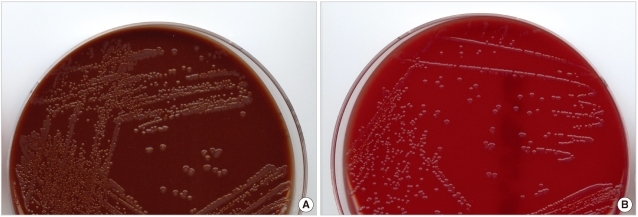Korean J Lab Med.
2011 Apr;31(2):118-121. 10.3343/kjlm.2011.31.2.118.
A Case of Bacteremia by Neisseria gonorrhoeae Coincident with Massive Hemorrhage of Esophageal Varices
- Affiliations
-
- 1Department of Laboratory Medicine, University of Ulsan College of Medicine, Asan Medical Center, Seoul, Korea. mnkim@amc.seoul.kr
- 2Department of Internal Medicine, University of Ulsan College of Medicine, Asan Medical Center, Seoul, Korea.
- KMID: 1094352
- DOI: http://doi.org/10.3343/kjlm.2011.31.2.118
Abstract
- A 42-yr-old man with hepatitis B virus associated liver cirrhosis was admitted to the emergency room because of multiple seizures, a history of chills and myalgia over the previous 2 weeks, and 3 days of melena. He was febrile with a temperature of 38.0degrees C. There were no symptoms and signs related to the genitourinary system, skin, or joints. Three sets of blood cultures were obtained and oxidase-positive, gram-negative diplococci were detected after 25.9-26.9 hr of incubation in all aerobic vials. The organism was positive for catalase and oxidase, and was identified as Neisseria gonorrhoeae, using a Vitek Neisseria-Haemophilus Identification card (bioMerieux Vitek, Inc., USA). Further, 16S rRNA sequencing of this isolate revealed a 99.9% homology with the published sequence of N. gonorrhoeae strain NCTC 83785 (GenBank Accession No. NR_026079.1). Acute bleeding by variceal rupture seems to be a likely route of introduction of N. gonorrhoeae from the mucosa into the blood. To the best of our knowledge, this is the first case of gonococcal bacteremia in Korea.
MeSH Terms
-
Adult
Bacteremia/complications/*diagnosis/microbiology
Catalase/metabolism
Esophageal and Gastric Varices/complications/*diagnosis
Gastrointestinal Hemorrhage/*etiology
Gonorrhea/complications/*diagnosis/microbiology
Humans
Ligation
Liver Cirrhosis/diagnosis
Male
Neisseria gonorrhoeae/genetics/*isolation & purification
Oxidoreductases/metabolism
RNA, Ribosomal, 16S/chemistry/genetics
Sequence Analysis, DNA
Figure
Cited by 1 articles
-
Disseminated Gonococcal Infection Presenting as Bacteremia and Liver Abscesses in a Healthy Adult
Min Hye Lee, Jongkyu Byun, Myounghwa Jung, John Jeongseok Yang, Ki-Ho Park, Soo-youn Moon, Hee Joo Lee, Mi Suk Lee
Infect Chemother. 2015;47(1):60-63. doi: 10.3947/ic.2015.47.1.60.
Reference
-
1. Clinical Laboratory Standards Institute. Twentieth informational supplement, M100-S20. Performance standards for antimicrobial susceptibility testing. 2010. Wayne, PA: Clinical Laboratory Standards Institute;p. 84–86.2. Winn WC, Allen SD, editors. Koneman's color atlas and textbook of diagnostic microbiology. 2006. 6th ed. Philadelphia: Lippincott Williams & Wilkins;p. 574–578.3. Marrazzo JM. Mandell GL, Bennett JE, editors. Neisseria gonorrhoeae. Principles and practice of infectious diseases. 2005. 7th ed. Philadelphia: Lippincott Williams & Wilkins;p. 2762–2765.
Article4. Kim GC, Lee CH, Lee JS, Chung MH, Choi JH, Moon YS. A case of concomitant disseminated gonococcal infection with acute viral hepatitis C. Infect Chemother. 2004; 36:175–180.5. Ellison RT 3rd, Curd JG, Kohler PF, Reller LB, Judson FN. Underlying complement deficiency in patients with disseminated gonococcal infection. Sex Transm Dis. 1987; 14:201–204. PMID: 2830678.
Article6. Kourilsky O, Leroy C, Peltier AP. Complement and liver cell function in 53 patients with liver disease. Am J Med. 1973; 55:783–790. PMID: 4796289.
Article7. Homann C, Varming K, Høgåsen K, Mollnes TE, Graudal N, Thomsen AC, et al. Acquired C3 deficiency in patients with alcoholic cirrhosis predisposes to infection and increased mortality. Gut. 1997; 40:544–549. PMID: 9176087.
Article8. Sobhonslidsuk A, Roongpisuthipong C, Nantiruj K, Kulapongse S, Songchitsomboon S, Sumalnop K, et al. Impact of liver cirrhosis on nutritional and immunological status. J Med Assoc Thai. 2001; 84:982–988. PMID: 11759979.9. Ashare A, Stanford C, Hancock P, Stark D, Lilli K, Birrer E, et al. Chronic liver disease impairs bacterial clearance in a human mo-del of induced bacteremia. Clin Transl Sci. 2009; 2:199–205. PMID: 20443893.
Article10. Cho JH, Park KH, Kim SH, Bang JH, Park WB, Kim HB, et al. Bacteremia is a prognostic factor for poor outcome in spontaneous bacterial peritonitis. Scand J Infect Dis. 2007; 39:697–702. PMID: 17654346.
Article11. Tapsall JW, Limnios EA, Abu Bakar HM, Darussalam B, Ping YY, Buadromo EM, et al. Surveillance of antibiotic resistance in Neisseria gonorrhoeae in the WHO Western Pacific and South East Asian regions, 2007-2008. Commun Dis Intell. 2010; 34:1–7. PMID: 20521493.12. Workowski KA, Berman SM. Sexually transmitted diseases treatment guidelines, 2006. MMWR Recomm Rep. 2006; 55:1–94. PMID: 16888612.
Article13. Janda W, Gaydos C. Murray PR, Baron EJ, editors. Neisseria. Manual of clinical microbiology. 2007. 9th ed. Washington, DC: ASM Press;p. 608.14. Park SH, Shim H, Yoon NS, Kim MN. Clinical relevance of time-to-positivity in BACTEC9240 blood culture system. Korean J Lab Med. 2010; 30:276–283. PMID: 20603588.
Article15. Bert F, Johnson JR, Ouattara B, Leflon-Guibout V, Johnston B, Marcon E, et al. Genetic diversity and virulence profiles of Escherichia coli isolates causing spontaneous bacterial peritonitis and bacteremia in patients with cirrhosis. J Clin Microbiol. 2010; 48:2709–2714. PMID: 20519468.16. Kang CI, Song JH, Ko KS, Chung DR, Peck KR. Clinical significance of Staphylococcus aureus infection in patients with chronic liver diseases. Liver Int. 2010; 30:1333–1338. PMID: 20492505.17. Rerknimitr R, Chanyaswad J, Kongkam P, Kullavanijaya P. Risk of bacteremia in bleeding and nonbleeding gastric varices after endoscopic injection of cyanoacrylate. Endoscopy. 2008; 40:644–649. PMID: 18561097.
Article18. Goulis J, Patch D, Burroughs AK. Bacterial infection in the pathogenesis of variceal bleeding. Lancet. 1999; 353:139–142. PMID: 10023916.
Article19. Yum JH, Shin SW, Ryeom G. Auxotype and antibiotic resistance pattern of Neisseria gonorrhoeae isolated in Korea. J Korean Soc Microbiol. 1995; 30:507–515.
- Full Text Links
- Actions
-
Cited
- CITED
-
- Close
- Share
- Similar articles
-
- Disseminated Gonococcal Infection Presenting as Bacteremia and Liver Abscesses in a Healthy Adult
- Prevalence of PPNG in Seoul, Korea ( 1983 ~ 1984 )
- Esophageal Motility and Acid Clearance in Patients with Esophageal Varices
- Surveillance for Spectinomycin Resistant Neisseria Gonorrhoeae
- Prevalence of serum antibodies to chlamydia trachomatis and neisseria gonorrhoeae in infertile patients


